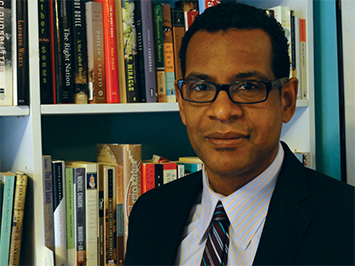AHA Activities
Five Myths about the American Historical Review
How does the American Historical Review (AHR) operate?
As the flagship journal of the American Historical Association, its procedures, guidelines, and general workings should be as transparent as possible. Here, then, I would like to address five possible myths about the AHR.
The rejection rate for article submissions to the AHR is so high-it's really a waste of time to submit something when the odds of acceptance are so poor.
It's true that, statistically speaking, the "odds" are not very favorable: only about 9 percent of submissions find their way into our pages. But a couple of things need to be underscored. First, many submissions are rejected simply because they don't meet the minimal guidelines for consideration: they're either much too short, or exceedingly long; they're on an extremely narrow topic; or they're written by people who have no idea that we're a journal of historical scholarship. Indeed, we receive many submissions whose authors clearly seem to believe we're the American Heritage magazine or another such publication aimed at a general readership. So the statistic cited above is somewhat misleading. If we were to count all serious submissions, the odds would be much less daunting.
Second, all submissions receive at least an in-house review; those considered promising are sent to two members of the Board of Editors; those that pass these two stages are sent for evaluation to three experts in the relevant field. In other words, you get something in return for submitting your work. We operate under the assumption that we are not only publishing the best possible work we can find, but also contributing to historical scholarship by providing constructive feedback on pieces that ultimately will be published elsewhere.
Yes, but you only publish work by senior scholars. Junior professors, recent PhDs, and graduate students don't stand a chance of having their work taken seriously by the AHR.
Not true! While it is somewhat rare for graduate students to have their work accepted, it has happened-and within recent memory. More to the point, most of our published authors are at the associate or even assistant professor level, and some have only recently completed their PhDs. Indeed, we find younger scholars often have the freshness of approach and intellectual energy that make them ideal authors to work with.
But it takes so long to get something published in the AHR-the review process is endless and the backlog of articles enormous.
Again, this is simply not the case. As of this writing (October 1), the articles I am accepting will be published in the April issue of the journal-that is, the current interval between acceptance and publication runs to around six months (it's often less). We do not, in other words, have a massive inventory of articles, such that final acceptance of your piece means an impossibly long wait for publication. It is true that our review process can be prolonged, involving three stages of evaluation (see above response to Myth #1). And alas, sometimes reviewers, especially outside experts, take advantage of the fact that the editor of the American Historical Review has little leverage over them. But we are careful to monitor the process, sending reminders and increasingly strongly worded nudges. And it must be said that the overwhelming majority of reviewers not only submit their reports in a timely manner but are also marvelously generous and detailed with their remarks. In short, the length of the review process varies quite a bit. Depending upon the state and quality of the initial manuscript, it can be either quite involved, meaning several rounds of revision, or relatively speedy. It is thus difficult to generalize about the time between the initial submission and publication. But an interval of a year is hardly unusual.
The AHR is not interested in work in my field. It almost never publishes anything in "X."
We publish between 25 and 30 articles a year over five issues. It should be remembered in this context that the AHR is rare among journals of historical scholarship in that our purview is unrestricted in terms of period and geographical area; our interests are global and cover all of recorded time (now even "deep" history). Since the '90s we have striven to break out of what had been a general bias towards European and North American history. I don't think that anyone can now accuse us of ethnocentrism. What this means is that some fields, topics and periods may seem slighted, when it's really a result of taking as catholic an approach to history as possible. We aim to publish highly accomplished work that has the greatest possibility of appealing to our wide readership-regardless of the field or period.
Books for review are assigned to reviewers on a haphazard basis. The AHR only rarely finds the right scholar to review a book.
We receive over 3,000 books a year for review; we only have the capacity, in terms of both labor and space, to review 1,000 titles. The whole process, from vetting books received, to finding and assigning potential reviewers, to receiving and copyediting reviews, is an enormously complex and prolonged one. We take every step of it very seriously-especially selecting a "pick-list" of potential reviewers. There are seven editorial assistants (EAs)-graduate students at Indiana University with expertise in various fields and languages-who take care of this process under the supervision of Moureen Coulter, assistant editor for book reviews. We have a database of more than 40,000 names-historians from around the world-which they use to select lists of potential reviewers for books. In drawing up these lists, the EAs consult with members of the Board of Editors as well as faculty at Indiana University. One thing to note is that in choosing potential reviewers, our long-standing policy is to eliminate everyone acknowledged or thanked by the author of the book-a cascade of names that can be very long indeed these days. The point is that in relatively small fields, with a handful of acknowledged experts, generously spreading your thanks can mean narrowing considerably the range of potential reviewers. While that can make our job harder, we take very seriously the task of finding the right scholars to review books.
If readers would like to learn more about the AHR, I invite them to attend the Meet the Editors and Staff session at the AHA annual meeting in Washington, DC. Or e-mail me.
—Robert A. Schneider (Indiana Univ.) is the editor of the American Historical Review.
AHR Welcomes New Members to the Board of Editors
We are happy to announce the appointment of five new members to the Board of Editors (pictured below). They join the eight currently serving members: David A. Bell (Princeton Univ.), Timothy Brook (Univ. of British Columbia), Harold J. Cook (Brown Univ.), Greg Grandin (New York Univ.), Susan Juster (Univ. of Michigan), Emily Rosenberg (Univ. of California, Irvine), Carol Symes (Univ. of Illinois, Urbana-Champaign), and Megan Vaughan (The Graduate Center, CUNY).
The primary responsibility of the members of the Board of Editors of the AHR is to review manuscripts sent to them by the editor. They also serve as an advisory council on all matters relating to the journal.
 Herman Bennett, The City University of New York |
 Belinda Davis, Rutgers University |
 Prasannan Parthasarathi, Boston College |
 Jan Plamper, Goldsmiths, University of London |
 Judith Tucker, Georgetown University |
Tags: American Historical Review Resources for History Departments Scholarly Communication Publishing Your Work
Comment
Please read our commenting and letters policy before submitting.






